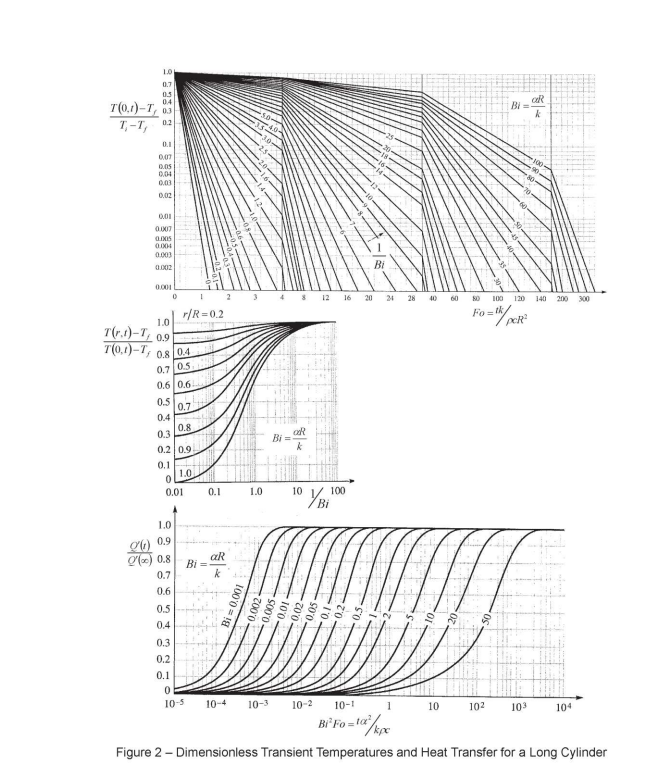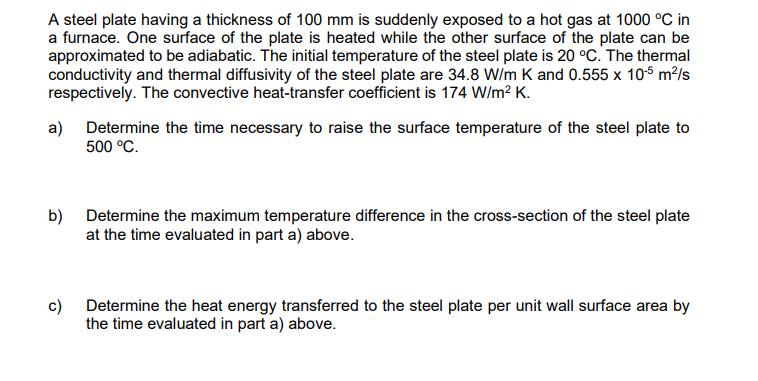A steel plate having a thickness of 100 mm is suddenly exposed to a hot gas at 1000 °C in a furnace. One surface of the plate is heated while the other surface of the plate can be approximated to be adiabatic. The initial temperature of the steel plate is 20 °C. The thermal conductivity and thermal diffusivity of the steel plate are 34.8 W/m K and 0.555 x 10-5 m²/s respectively. The convective heat-transfer coefficient is 174 W/m² K. a) Determine the time necessary to raise the surface temperature of the steel plate to 500 °C. b) Determine the maximum temperature difference in the cross-section of the steel plate at the time evaluated in part a) above. c) Determine the heat energy transferred to the steel plate per unit wall surface area by the time evaluated in part a) above.
A steel plate having a thickness of 100 mm is suddenly exposed to a hot gas at 1000 °C in a furnace. One surface of the plate is heated while the other surface of the plate can be approximated to be adiabatic. The initial temperature of the steel plate is 20 °C. The thermal conductivity and thermal diffusivity of the steel plate are 34.8 W/m K and 0.555 x 10-5 m²/s respectively. The convective heat-transfer coefficient is 174 W/m² K. a) Determine the time necessary to raise the surface temperature of the steel plate to 500 °C. b) Determine the maximum temperature difference in the cross-section of the steel plate at the time evaluated in part a) above. c) Determine the heat energy transferred to the steel plate per unit wall surface area by the time evaluated in part a) above.
Principles of Heat Transfer (Activate Learning with these NEW titles from Engineering!)
8th Edition
ISBN:9781305387102
Author:Kreith, Frank; Manglik, Raj M.
Publisher:Kreith, Frank; Manglik, Raj M.
Chapter2: Steady Heat Conduction
Section: Chapter Questions
Problem 2.55P: 2.55 A long, 1-cm-diameter electric copper cable is embedded in the center of a 25-cm-square...
Related questions
Question
100%

Transcribed Image Text:1.0
0.7
0.5
0.4
T(0.1)-T, 03
T-T,
0.2
0.1
0.07
0.05
0,04
0.03
0.02
0.01
0.007
0.005
0.004
0.003
0.002
0.001
0.5
0.4
1.0
T(r.1)-T,
0.9
T(0.1)-T, 0.8 0.4
0.7
0.5
0.6 0.6
0.8
0.3
0.2 0.9
0.1
1.0
L) 0.9
Q(x) 0.8
883
0
0.7
0
0.01
0.6
1
r/R=0.2
0.5
0.4
0.3
0.2
0.1
0.7
1.0
0.1
aR
Bi=-
0
10-5 10-4
2 3 4 8 12 16
1.0
Bi=
Bi = 0.001
0.002-
0.005
100.
CR
k
10 Bi
100
10-3 10-2 10-1
Bi
20
24 28
1
40
10
60
80
Bi=
100 120
Fo=tk/pcR²
10²
aR
k
103
Bi³ Fo=to²/kpc
Figure 2 - Dimensionless Transient Temperatures and Heat Transfer for a Long Cylinder
140
200 300
104

Transcribed Image Text:A steel plate having a thickness of 100 mm is suddenly exposed to a hot gas at 1000 °C in
a furnace. One surface of the plate is heated while the other surface of the plate can be
approximated to be adiabatic. The initial temperature of the steel plate is 20 °C. The thermal
conductivity and thermal diffusivity of the steel plate are 34.8 W/m K and 0.555 x 10-5 m²/s
respectively. The convective heat-transfer coefficient is 174 W/m²K.
a)
Determine the time necessary to raise the surface temperature of the steel plate to
500 °C.
b) Determine the maximum temperature difference in the cross-section of the steel plate
at the time evaluated in part a) above.
c)
Determine the heat energy transferred to the steel plate per unit wall surface area by
the time evaluated in part a) above.
Expert Solution
This question has been solved!
Explore an expertly crafted, step-by-step solution for a thorough understanding of key concepts.
Step by step
Solved in 4 steps with 8 images

Knowledge Booster
Learn more about
Need a deep-dive on the concept behind this application? Look no further. Learn more about this topic, mechanical-engineering and related others by exploring similar questions and additional content below.Recommended textbooks for you

Principles of Heat Transfer (Activate Learning wi…
Mechanical Engineering
ISBN:
9781305387102
Author:
Kreith, Frank; Manglik, Raj M.
Publisher:
Cengage Learning

Principles of Heat Transfer (Activate Learning wi…
Mechanical Engineering
ISBN:
9781305387102
Author:
Kreith, Frank; Manglik, Raj M.
Publisher:
Cengage Learning